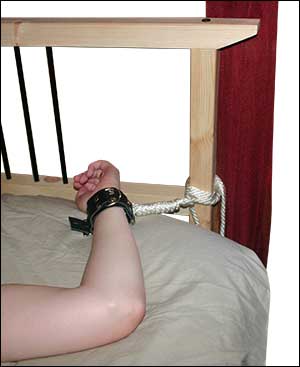 |
|
Cuffs are a great time-saver in the kinkster's bedroom. They save having to learn complicated knots; they're a cinch to put on and take off; many of them are very comfortable; and they're available in a wide variety of styles, colors, and materials, so they're excellent fashion accessories as well.
TYPES OF CUFFS
You can look around and find all sorts of styles of cuffs, made of all kinds of different materials and with many different designs. They all have the same basic purpose--to wrap around a wrist or ankle (or other part of the body) in order to hold a person secure. There are several approaches to doing this, though, and several different ways they go about getting the job done.
|
The variety of cuffs most people are probably familiar with is the basic police-issue set of handcuffs. Handcuffs are narrow metal cuffs with a ratchet mechanism and a key lock designed so that a key is required to open them; they're made in pairs, with a short chain, bar, or hinge between them.
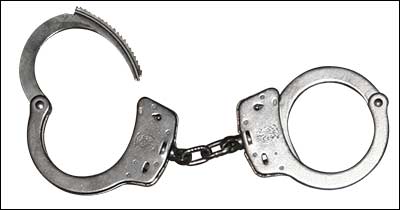
Handcuffs are inexpensive, easy to find, and easy to use. You can even get cheap novelty cuffs lined with fur a many sex toy stores. However, they have several significant drawbacks when it comes to sex play, and as a result, many experienced kinksters tend to stay away from them except in certain circumstances.
The narrowness and hardness of handcuffs means they can become very painful, or even cause injury, if your partner pulls or struggles against them. The pressure of the metal against the wrist can cause nerve damage if the cuffs are tightened too far or if your partner exerts pressure on them. For that reason, they're not a good choice for any sort of role-play or scenario where your partner will be struggling.
Good handcuffs are "double locking." That means they have a lock that can be used to prevent them from closing any farther; you put the handcuffs on your partner and set the double lock so that the cuffs won't open or close. This keeps them from tightening unexpectedly if you or your partner accidentally press on them.
Fetters, or irons, are a special category of cuffs that are similar to handcuffs in the sense that they're made of metal and often have a locking or ratcheting mechanism, connected by a chain or bar. Unlike normal handcuffs, fetters are usually linked by a longer chain, and some varieties are designed for use on the ankles rather than the wrists.
The most basic (and most useful) type of cuff for kinky play is a buckling cuff made of nylon, leather, rubber, or some similar material. These can be found in a mind-boggling assortment of colors, widths, sizes, textures, and materials; generally speaking, they'll all have a sliding or buckling mechanism of some sort, which may be lockable, and one or more attachment points for ropes, hook, chains, and so on.
A few things to consider about these kinds of cuffs:
- Some cuffs are available with velvet or fur lining on the inside. These are said to make the cuffs more comfortable. I've found that what they do is make the cuffs more bulky, and sometimes harder to work with, but rarely more comfortable.
- All other things being equal, wider cuffs are often more comfortable than narrower cuffs of the same design and materials, especially when the wearer pulls against them, because the force is distributed over a larger area.
- Cuffs with more than one attachment point can be useful for situations where you want to immobilize someone in more than one axis. For example, you can use a spreader bar to hold your partner's hands or feet apart, and also tie the cuffs down as well.
Normal cuffs should never be used to suspend a person or to support a person's weight. They are not designed for it, and can concentrate a great deal of force over a small area. If you wish to use cuffs in a way that will bear your partner's weight, you'll need special-purpose suspension cuffs designed for the job.
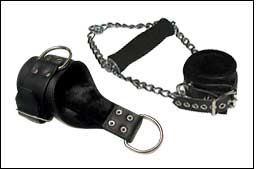 You'll find a few different common varieties of suspension cuff, two of which are shown here. A "grip cuff" (top) is a conventional cuff attached to a handle which the wearer holds; a wraparound cuff (bottom) is a large, wide band that wraps around the wearer's wrist and hand to support the wearer's weight. You'll find a few different common varieties of suspension cuff, two of which are shown here. A "grip cuff" (top) is a conventional cuff attached to a handle which the wearer holds; a wraparound cuff (bottom) is a large, wide band that wraps around the wearer's wrist and hand to support the wearer's weight.
These cuffs are intended for supporting a person's entire weight, and can be used to suspend someone completely off the ground. They're useful for more than just suspension, though. In particular, they're useful for any kind of scenario in which your partner will be struggling or resisting by force, such as a resistance play or rape play scenario, or just in general any time you might expect your partner to pull against the restraints. They look more intimidating to some people than ordinary handcuffs, but they're much safer.
A third variety of suspension cuffs is intended for hanging a person upside down by the feet, and consists of specially-designed boots fitted with a fixture from which to suspend the wearer.
There's more to cuffs than things that go around your wrists and ankles. In the next section, we'll explore some different varieties of cuffs and belts beyond the basic types shown here.
What you'll need

|
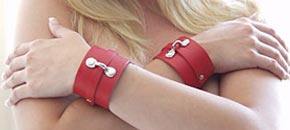
|
|
Basic Wrist Cuffs
Adjustable cuffs
with reinforced leather
band |
| These are solid, functional, inexpensive wrist cuffs suitable for basic bondage. Each includes a solid metal D-ring that makes attaching a rope or snap hook. These cuffs are comfortable and easily adjusted. Available in black, red, or pink. |
|
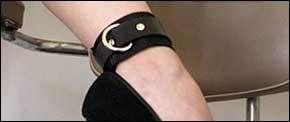
|
|
Leather Ankle Cuffs
Adjustable leather cuffs
with D-ring |
| Like the wrist cuffs above, these are solid, functional, inexpensive ankle cuffs that work well for basic bondage. Each includes a solid metal D-ring that makes attaching a rope or snap hook. These cuffs are comfortable and easily adjusted. Available in black, red, or pink. |
|

|
|
Wrist/Ankle Cuff Set
Four 12" long Velcro
cuffs with nylon leads, incudes
adjustable blindfold. |
| This kit offers almost everything you need to get started--four cuffs affixed to nylon tie-down leads and one blindfold. The cuffs themselves adjust to any size wrist or ankle; each has a Velcro closure that's infinitely adjustable. |
|
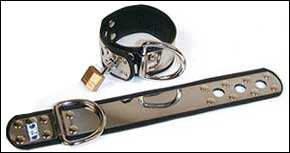
|
|
Leather and Steel Wrist Cuffs
Leather and Steel Ankle Cuffs
Polished jewelry-grade
stainless steel wrist or ankle cuffs
with lockable closures |
| These gorgeous polished steel cuffs are both very comfortable and very secure. The wrist cuffs adjust from 5.75" to 9" and the ankle cuffs adjust from 7" to 10". You can also find a matching collar here. |
|
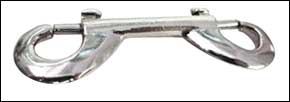
|
|
Double-Ended Snap Hook (4-pack)
Nickel-plated, set of 4 |
| Snap hooks make for a quick, convenient way to hook a set of cuffs to straps, eyebolts, tie-down points, ropes, or just about anything else. No knot-tying skill is necessary, and your partner can be restrained and freed quickly. |
|
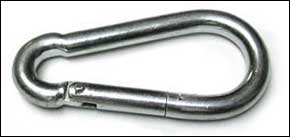
|
|
Carabiner hook
3" long, 3/8" wide at narrowest
point, spring-loaded lever |
| Carabiners are a versatile, quick way to fasten cuffs or other restraints to tie-down points. The design of the carabiner offers more flexibility than the snap hook above; you can, for example, attach two cuffs to the same tie-down point with the carabiner. You can use them for other purposes as well; I use them to hang floggers from my belt loop or from a stand, for example. Keep a handful of these handy; you'll find all sorts of uses for them! |

| I've listed these cuffs under "intermediate exploration" because I don't generally recommend them for people who are new to bondage. Handcuffs can be a lot of fun, but they should be used with care; they're very hard, and can cause injury if your partner struggles against them. I strongly recommend that you do not use single-locking handcuffs for bondage play. |
|
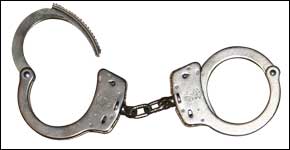
|
|
Silver Double-Locking Handcuffs
Police-issue standard handcuffs
with double locks, includes
two standard handcuff keys |
| Standard police-issue handcuffs are generally safer than cheap "novelty" handcuffs, because they feature a double lock to prevent the cuff from accidentally overtightening. |

|
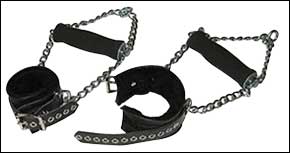
|
|
Grip Suspension Cuffs
Adjustable padded cuffs with
chains and padded
grip bars; available
in two sizes |
| These cuffs can be used for suspension or for any scenario where your partner's hands will be cuffed above his or her head. They're also useful for non-suspension scenes in which your partner may pull or struggle against the cuffs; for example, you can use them to cuff your partner over a bench or table for strong impact play.
Suspension is an activity that involves risk and should not be done by people who are not skilled and knowledgeable. Cuffs and other equipment specifically designed for suspension can make it safer, but ultimately it's your responsibility to know what you're doing and to assume any risks from doing it.
|
|
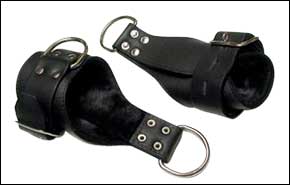
|
|
Wrist Suspension Cuffs
Adjustable buckling leather
cuffs with fleece lining and
heavy-duty suspension point,
available in two colors |
| These cuffs are designed for suspension and distribute the wearer's weight across the palms. As with any suspension gear, these cuffs should be used for suspension only by skilled and knowledgeable people. |
|
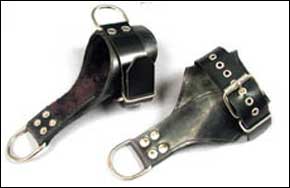
|
|
Ankle Suspension Cuffs
Adjustable buckling leather
cuffs with fleece lining and
heavy-duty suspension point
|
| These ankle cuffs are the same design as the wrist suspension cuffs above, but slightly larger. They were designed for inverted suspension by the ankles--but, as you no doubt already know, this is the sort of activity that should only be undertaken by experienced kinksters. |
|
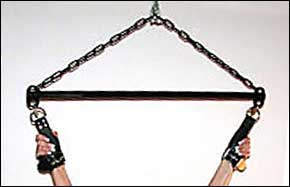
|
|
Suspension Bar
36" long, heavy steel bar with
18" chains welded to each side;
includes bolt for securing the chains
together to form a single
attachment point.
Available in black or chrome. |
| This bar is designed to serve as an attachment point for suspension bondage. It can be fastened to an overhead point, and will easily accommodate a person's weight. The bar has a heavy welded attachment point on each end for cuffs. |
|
|


 This site is part of Franklin Veaux's Sprawling Web Empire™
This site is part of Franklin Veaux's Sprawling Web Empire™